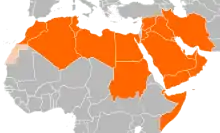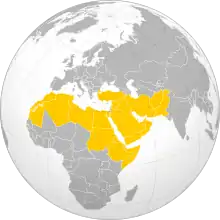MENA
MENA is an English-language acronym referring to the Middle East and North Africa. It is alternatively called the WANA (West Asia and North Africa). The MENA acronym is often used in academia, military planning, disaster relief, media planning as a broadcast region, and business writing.[1][2] Moreover, the region shares a number of cultural, economic and environmental similarities across the countries; for example, some of the most extreme impacts of climate change will be felt in the region.
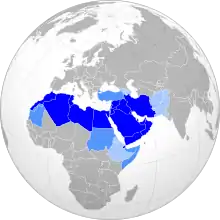
Some terms have a wider definition than MENA, such as MENAP, MENAPA or Greater Middle East, which also include the South Asian countries of Afghanistan and Pakistan. The term MENAT explicitly includes Turkey, which is usually excluded from MENA definitions, even though Turkey is almost always considered part of the 'Middle East'.
Definitions
"MENA" has no standardized definition; different organizations define the region as consisting of different territories, or do not define it as a region at all.
United Nations
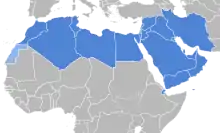
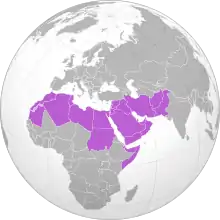
There is no MENA region amongst the United Nations Regional Groups, nor in the United Nations geoscheme used by the UNSD (though the latter does feature two subregions called 'Western Asia' and 'Northern Africa', see WANA). Some agencies and programmes of the United Nations do define the MENA region, but their definitions may contradict each other, and sometimes only apply to specific studies or reports.
- A 2003 World Bank study stated: 'In World Bank geographic classification, the following 21 countries or territories constitute the Middle East and North Africa (MENA) region: six Gulf Cooperation Council (GCC) members (Bahrain, Kuwait, Oman, Qatar, Saudi Arabia, and United Arab Emirates [UAE]), and 15 other countries or territories: Algeria, Djibouti, the Arab Republic of Egypt, Iraq, the Islamic Republic of Iran, Israel, Jordan, Lebanon, Libya, Malta, Morocco, the Republic of Yemen, the Syrian Arab Republic, Tunisia, and West Bank and Gaza.'[3]:20 As of January 2021, the World Bank website groups the same set of 21 countries/territories as MENA: 'Algeria; Bahrain; Djibouti; Egypt, Arab Rep.; Iran, Islamic Rep.; Iraq; Israel; Jordan; Kuwait; Lebanon; Libya; Malta; Morocco; Oman; Qatar; Saudi Arabia; Syrian Arab Republic; Tunisia; United Arab Emirates; West Bank and Gaza; Yemen, Rep..'.[4]
- A 2010 UNHCR report stated: 'For the purposes of this study, the MENA region has been defined as comprising of the following 18 countries: Algeria, Bahrain, Egypt, Iraq, Jordan, Kuwait, Lebanon, Libya, Mauritania, Morocco, Oman, Occupied Palestinian Territories, Qatar, Saudi Arabia, Syria, Tunisia, United Arab Emirates and Yemen.'[7]:2
- A 2015 FAO report stated: 'The 21 MENA countries are Algeria, Bahrain, Djibouti, Egypt, Iran, Israel, Jordan, Kuwait, Lebanon, Libya, Malta, Morocco, Oman, Palestine, Qatar, Saudi Arabia, Syria, Tunisia, United Arab Emirates and Yemen.'[8]
- The UNAIDS regional classification of the Middle East and North Africa region 'includes 20 countries/territories: Algeria, Bahrain, Djibouti, Egypt, Iran, Iraq, Jordan, Kuwait, Lebanon, Libya, Morocco, Oman, Qatar, Saudi Arabia, Somalia, Sudan, Syrian Arab Republic, Tunisia, United Arab Emirates and Yemen,' according to a 2019 UNICEF report.[5]:11
- As of January 2021, the UNICEF website groups the following set of 20 countries as MENA: 'Algeria, Bahrain, Djibouti, Egypt, Iran (Islamic Republic of), Iraq, Jordan, Kuwait, Lebanon, Libya, Morocco, Oman, Qatar, Saudi Arabia, State of Palestine, Sudan, Syrian Arab Republic, Tunisia, United Arab Emirates, Yemen.'[9]
- Working for the International Monetary Fund (IMF), economists Hamid Reza Davoodi and George T. Abed wrote in 2003: 'The MENA region comprises the Arab States in the Middle East and North Africa—Algeria, Bahrain, Djibouti, Egypt, Iraq, Jordan, Kuwait, Lebanon, Libya, Mauritania, Morocco, Oman, Qatar, Saudi Arabia, Somalia, Sudan, the Syrian Arab Republic, Tunisia, the United Arab Emirates, and Yemen—plus the Islamic State of Afghanistan, the Islamic Republic of Iran, Pakistan, the West Bank and Gaza.' The authors emphasise that these '24 MENA countries (...) are grouped together for analytical purposes only.' Although they allegedly 'share common challenges and cultural links distinct from neighbouring economies' such as Israel and Turkey, and Islam is the dominant religion and Arabic the principal language, there are 'sizable religious minority groups' and 'significant linguistic diversities' in the MENA region, with Afghanistan, Iran and Pakistan not having Arabic as the majority language.[6]
| Country or territory | World Bank MENA 2003[3][4] | FAO MENA 2015[8] | UNAIDS MENA 2019[5] | UNICEF MENA 2021[9] | UNHCR MENA 2010[7] | IMF MENA 2003[6] | UNSD WA+NA[10] |
|---|---|---|---|---|---|---|---|
| No | No | No | No | No | Yes | No | |
| Yes | Yes | Yes | Yes | Yes | Yes | Yes | |
| No | No | No | No | No | No | Yes | |
| No | No | No | No | No | No | Yes | |
| Yes | Yes | Yes | Yes | Yes | Yes | Yes | |
| No | No | No | No | No | No | Yes | |
| Yes | Yes | Yes | Yes | No | Yes | No | |
| Yes | Yes | Yes | Yes | Yes | Yes | Yes | |
| No | No | No | No | No | No | Yes | |
| Yes | Yes | Yes | Yes | No | Yes | No | |
| Yes | No | Yes | Yes | Yes | Yes | Yes | |
| Yes | Yes | No | No | No | No | Yes | |
| Yes | Yes | Yes | Yes | Yes | Yes | Yes | |
| Yes | Yes | Yes | Yes | Yes | Yes | Yes | |
| Yes | Yes | Yes | Yes | Yes | Yes | Yes | |
| Yes | Yes | Yes | Yes | Yes | Yes | Yes | |
| Yes | No | No | No | Yes | No | No | |
| No | No | No | No | Yes | Yes | No | |
| Yes | Yes | Yes | Yes | Yes | Yes | Yes | |
| Yes | Yes | Yes | Yes | Yes | Yes | Yes | |
| No | No | No | No | No | Yes | No | |
| Yes | Yes | No | Yes | Yes | Yes | Yes | |
| Yes | Yes | Yes | Yes | Yes | Yes | Yes | |
| Yes | Yes | Yes | Yes | Yes | Yes | Yes | |
| No | No | Yes | No | No | Yes | No | |
| No | No | Yes | Yes | No | Yes | Yes | |
| Yes | Yes | Yes | Yes | Yes | Yes | Yes | |
| Yes | Yes | Yes | Yes | Yes | Yes | Yes | |
| No | No | No | No | No | No | Yes | |
| Yes | Yes | Yes | Yes | Yes | Yes | Yes | |
| Unclear | Unclear | Unclear | Unclear | Unclear | Unclear | Yes | |
| Yes | Yes | Yes | Yes | Yes | Yes | Yes | |
| *Also called State of Palestine, (Occupied) Palestinian Territories, Palestinian Authority, or West Bank and Gaza (Strip). | |||||||
WANA
.png.webp)
Due to the geographic ambiguity and Eurocentric nature of the term "Middle East", some people, especially in sciences such as agriculture and climatology, prefer to use other terms like "WANA" (West Asia and North Africa)[11] or the less common NAWA (North Africa-West Asia).[12] Usage of the term WANA has also been advanced by postcolonial studies.[13]
The United Nations geoscheme used by the UNSD does not define a single WANA region, but it does feature two subregions called Western Asia, and Northern Africa, respectively:[10]
- Western Asia (18): Armenia, Azerbaijan, Bahrain, Cyprus, Georgia, Iraq, Israel, Jordan, Kuwait, Lebanon, Oman, Qatar, Saudi Arabia, State of Palestine, Syrian Arab Republic, Turkey, United Arab Emirates, Yemen.
- Northern Africa (7): Algeria, Egypt, Libya, Morocco, Sudan, Tunisia, Western Sahara.
In a 1995 publication, the then-Aleppo-based International Center for Agricultural Research in the Dry Areas (ICARDA) defined its West Asia/North Africa (WANA) region as 25 countries, including: 'Afghanistan, Algeria, Egypt, Ethiopia, Iran, Iraq, Jordan, Lebanon, Libya, Morocco, Oman, Pakistan, Saudi Arabia, Sudan, Syria, Tunisia, Turkey and Yemen.'[15] It noted that CGIAR's Technical Advisory Committee (TAC) excluded Ethiopia, Sudan and Pakistan from its 1992 WANA definition, but otherwise listed the same countries.[15] In a 2011 study, ICARDA stated 27 countries/territories: 'The WANA region includes: Afghanistan, Algeria, Bahrain, Djibouti, Egypt, Eritrea, Ethiopia, Gaza Strip, Iran, Iraq, Jordan, Kuwait, Lebanon, Libya, Mauritania, Morocco, Oman, Pakistan, Qatar, Saudi Arabia, Somalia, Sudan, Syria, Tunisia, Turkey, United Arab Emirates, and Yemen.'[14]
| Country or territory | UNSD WA+NA[10] | CGIAR WANA 1992[15] | ICARDA WANA 1995[15] | ICARDA WANA 2011[14] |
|---|---|---|---|---|
| Afghanistan | No | Yes | Yes | Yes |
| Algeria | Yes | Yes | Yes | Yes |
| Armenia | Yes | No | No | No |
| Azerbaijan | Yes | No | No | No |
| Bahrain | Yes | Unclear | Unclear | Yes |
| Cyprus | Yes | No | No | No |
| Djibouti | No | Unclear | Unclear | Yes |
| Egypt | Yes | Yes | Yes | Yes |
| Eritrea | No | No | Probably | Yes |
| Ethiopia | No | No | Yes | Yes |
| Georgia | Yes | No | No | No |
| Iran | No | Yes | Yes | Yes |
| Iraq | Yes | Yes | Yes | Yes |
| Israel | Yes | Unclear | Unclear | No |
| Jordan | Yes | Yes | Yes | Yes |
| Kuwait | Yes | Yes | Yes | Yes |
| Lebanon | Yes | Yes | Yes | Yes |
| Libya | Yes | Yes | Yes | Yes |
| Mauritania | No | Unclear | Unclear | Yes |
| Morocco | Yes | Yes | Yes | Yes |
| Oman | Yes | Yes | Yes | Yes |
| Palestine* | Yes | Unclear | Unclear | Partial |
| Pakistan | No | No | Yes | Yes |
| Qatar | Yes | Yes | Yes | Yes |
| Saudi Arabia | Yes | Yes | Yes | Yes |
| Somalia | No | Unclear | Unclear | Yes |
| Sudan | Yes | No | Yes | Yes |
| Syria | Yes | Yes | Yes | Yes |
| Tunisia | Yes | Yes | Yes | Yes |
| Turkey | Yes | Yes | Yes | Yes |
| U.A.Emirates | Yes | Unclear | Unclear | Yes |
| W. Sahara | Yes | Unclear | Unclear | Unclear |
| Yemen | Yes | Yes | Yes | Yes |
*Also called State of Palestine, or West Bank and Gaza (Strip).
Other definitions
Historians Michael Dumper and Bruce Stanley stated in 2007: 'For the purposes of this volume, the editors have generally chosen to define the MENA region as stretching from Morocco to Iran and from Turkey to the Horn of Africa. This definition thus includes the twenty-two countries of the Arab League (including the Palestinian Authority enclaves in the West Bank and Gaza Strip), Turkey, Israel, Iran, and Cyprus.' They stressed, however, how controversial and problematic this definition is, and that other choices could also have been made according to various criteria.[16]
For its December 2012 global religion survey, the Pew Research Center grouped 20 countries and territories as 'the Middle East and North Africa', namely: 'Algeria, Bahrain, Egypt, Iraq, Israel, Jordan, Kuwait, Lebanon, Libya, Morocco, Oman, the Palestinian territories, Qatar, Saudi Arabia, Sudan, Syria, Tunisia, United Arab Emirates, Western Sahara and Yemen.'[17]
For the Global Peace Index 2020, the Institute for Economics & Peace defined the MENA region as containing 20 countries: Algeria, Bahrain, Egypt, Iraq, Iran, Israel, Jordan, Kuwait, Lebanon, Libya, Morocco, Oman, Palestine, Qatar, Saudi Arabia, Sudan, Syria, Tunisia, United Arab Emirates, and Yemen.[18]
Climate change
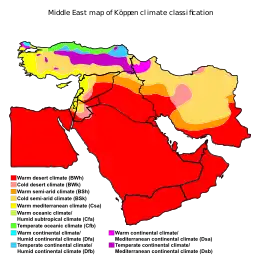
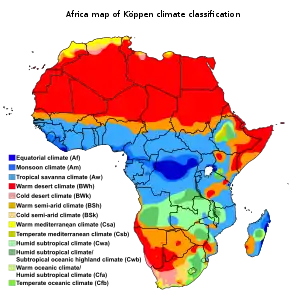
Climate change in the Middle East and North Africa (MENA) refers to changes in the climate of the MENA region and the subsequent response, adaption and mitigation strategies of countries in the region. In 2018, the MENA region emitted 3.2 billion tonnes of carbon dioxide and produced 8.7% of global greenhouse gas emissions (GHG)[19] despite making up only 6% of the global population.[20] These emissions are mostly from the energy sector,[21] an integral component of many Middle Eastern and North African economies due to the extensive oil and natural gas reserves that are found within the region.[22][23]
Recognised by the United Nations, The World Bank and the World Health Organisation as one of the greatest global challenges in the 21st century, climate change is currently having an unprecedented effect upon the Earth's natural systems.[24][25][26] Sharp global temperature and sea level changes, shifting precipitation patterns and increased frequency of extreme weather events are some of the main impacts of climate change as identified by the Intergovernmental Panel on Climate Change (IPCC).[27] The MENA region is especially vulnerable to such impacts due to its arid and semi-arid environment, facing climatic challenges such as low rainfall, high temperatures and dry soil.[27][28] The climatic conditions that foster such challenges for MENA are projected by the IPCC to worsen throughout the 21st century.[27] If greenhouse gas emissions are not significantly reduced, part of the MENA region risks becoming uninhabitable before the year 2100.[29][30][31]
Climate change is expected to put significant strain on already scarce water and agricultural resources within the MENA region, threatening the national security and political stability of all included countries.[32] This has prompted some MENA countries to engage with the issue of climate change on an international level through environmental accords such as the Paris Agreement. Policy is also being established on a national level amongst MENA countries, with a focus on the development of renewable energies.[33]Culture
Human rights
Religion
Islam is by far the dominant religion in nearly all of the MENA territories; 91.2% of the population is Muslim. The Middle East–North Africa region comprises 20 countries and territories with an estimated Muslim population of 315 million or about 23% of the world's Muslim population.[34] The term "MENA" is often defined in part in relation to majority-Muslim countries located in the region, although several nations in the region are not Muslim-dominated.[35] Major non-Islamic religions native here are Christianity, Judaism, Yazidism, Druzeism, African folk religions, Berberism and other Arab paganism.
Migrant population, mostly within the Gulf nations, practice mostly the beliefs they follow to, such as Buddhism and Hinduism among South Asian, East Asian and Southeast Asian migrants.[36][37]
Demographics
The Demographics of the Middle East and North Africa (MENA) region show a highly populated, culturally diverse region spanning three continents. As of 2018, the population was nearly 578 million. The class, cultural, ethnic, governmental, linguistic and religious make-up of the region is highly variable.
Debates on which countries should be included in the Middle East are wide-ranging.[38] The Greater Middle East and North Africa region can include the Caucasus, Cyprus, Afghanistan, and several sub-Saharan African states due to various social, religious and historic ties. The most commonly accepted countries in the MENA region are included on this page.Economy and education
The MENA region has vast reserves of petroleum and natural gas that make it a vital source of global economic stability. According to the Oil and Gas Journal (January 1, 2009), the MENA region has 60% of the world's oil reserves (810.98 billion barrels (128.936 km3)) and 45% of the world's natural gas reserves ( 2,868,886 billion cubic feet (81,237.8 km3) ).[39]
As of 2011, 8 of the 15 OPEC nations are within the MENA region.
According to Pew Research Center's 2016 "Religion and Education Around the World" study, 40% of the adult population in MENA had completed less than a year of primary school. The fraction was higher for women, of whom half had been to school for less than a year.[40]
Politics
Stability and instability in the region
In its Global Peace Index 2020, the Institute for Economics & Peace stated that 'the Middle East and North Africa remains the world's least peaceful region, despite improvements for 11 countries'.[18] According to an in-depth multi-part study by the Center for Strategic and International Studies (CSIS) published in April 2016, the factors shaping the MENA region are exceedingly complex, and it is difficult to find 'any overall model that fits the different variables involved'. It found that there were 'deep structural causes of violence and instability'. Wars and upheavals are partly 'shaped by the major tribal, ethnic, sectarian, and regional differences', by 'demographic, economic, and security trends', and by 'quality of governance, internal security system, justice systems, and [social] progress.' In some countries, the necessary societal factors for successful democratic change (often championed by some in the region and in the West to address various issues) are absent, and political revolutions may not always lead to more stability, nor solve the underlying problems in a given MENA country. However, it also found that 'the majority of MENA nations have remained relatively stable and continue to make progress'.[41]
Armed conflicts
During and after the decolonisation of Africa and Asia in the 20th century, many different armed conflicts have occurred in the MENA region, including but not limited to the Rif War; the Iraqi–Kurdish conflict; the Arab–Israeli conflict; the Western Sahara conflict; the Lebanese Civil War; the Kurdish–Turkish conflict (1978–present); the Iranian Revolution; the Iran–Iraq War; Iran–Saudi Arabia proxy conflict; the Berber Spring; the Toyota War; the Invasion of Kuwait and the Gulf War; the Algerian Civil War; the Iraqi Kurdish Civil War; the rise of terrorism and anti-terrorist actions; the U.S.-led intervention of Iraq in 2003 and subsequent Iraq War. The Arab Spring (2010–2011) led to the Tunisian Revolution, the Egyptian revolution of 2011 and Egyptian Crisis (2011–2014), while also sparking war throughout the region such as the Syrian Civil War, the Libyan Civil War, the Yemeni Civil War and the Iraqi war against ISIS (Islamic State of Iraq and the Levant). During the Sudanese Revolution, months of protestes and a military coup led to the fall of Omar al-Bashir's regime and the initiation of the 2019–2022 Sudanese transition to democracy and the Sudanese peace process.[42]
Related terms
.svg.png.webp)
- Greater Middle East
In a preparatory working paper for the June 2004 G8 Summit, the U.S. government (at the end of the George W. Bush administration's first term) defined the 'Greater Middle East as including the Arab states, Israel, Turkey, Iran, Pakistan and Afghanistan.[43]
- MENAP
From April 2013, the International Monetary Fund started using a new analytical region called MENAP (Middle East, North Africa, Afghanistan, and Pakistan), which adds Afghanistan and Pakistan to MENA countries.[44] Now MENAP is a prominent economic grouping in IMF reports.[45][46]
- MENAT
The term MENAT (Middle East, North Africa, and Turkey) has been used to include Turkey in the list of MENA countries.[47][48]
- Near East
The term Near East was commonly used before the term Middle East was coined by the British in the early 20th century. The term Ancient Near East is commonly used by scholars for the region in antiquity. Some organisations and scholars insist on still using 'Near East' today, with some including North Africa, but definitions range widely and there is no consensus on its geographical application.
See also
| Look up MENA in Wiktionary, the free dictionary. |
References
- "World Bank Definition: MENA". Worldbank.org. Archived from the original on 29 October 2014. Retrieved 28 November 2014.
- "World Economic Forum on the Middle East and North Africa, Marrakech, Morocco, 26-28 October 2010". World Economic Forum on the Middle East and North Africa 2010 - World Economic Forum. Archived from the original on 10 April 2012. Retrieved 28 November 2014.
- Dipak Dasgupta & Mustapha Kamel Nabli (August 2003). "Trade, Investment, and Development in the Middle East and North Africa" (PDF). documents1.worldbank.org. World Bank. Retrieved 16 January 2021.
- "Middle East & North Africa". data.worldbank.org. World Bank. Retrieved 16 January 2021.
- Tamara Sutila (ed) (July 2019). "Seizing the Opportunity: Ending AIDS in the Middle East and North Africa" (PDF). unicef.org. UNICEF. Retrieved 16 January 2021.CS1 maint: extra text: authors list (link)
- George T. Abed, Hamid Reza Davoodi (2003). Challenges of Growth and Globalization in the Middle East and North Africa. International Monetary Fund. p. 2. Retrieved 16 January 2021.CS1 maint: uses authors parameter (link)
- Laura van Waas (October 2010). "The situation of stateless persons in the Middle East and North Africa" (PDF). UNHCR. Retrieved 16 January 2021.
- Nuno Santos & Iride Ceccacci (2015). "Egypt, Jordan, Morocco and Tunisia: Key trends in the agrifood sector" (PDF). fao.org. FAO. Retrieved 16 January 2021.
- "Middle East and North Africa". unicef.org. UNICEF. Retrieved 16 January 2021.
- "Methodology: Standard country or area codes for statistical use (M49)". unstats.un.org. United Nations. Retrieved 17 January 2021.
- "West Asia and North Africa: A Regional Vision". Worldbank.org. Archived from the original on 27 October 2014. Retrieved 28 November 2014.
- "Welcome". Agu.org. Archived from the original on 30 April 2005. Retrieved 28 November 2014.
- Kohlenberg, Paul J.; Godehardt, Nadine (2020). The Multidimensionality of Regions in World Politics. Abingdon: Routledge. p. 86. ISBN 9781000168648. Retrieved 19 January 2021.
- Mustafa Pala, Theib Oweis, Bogachan Benli, Eddy De Pauw, Mohammed El Mourid, Mohammed Karrou, Majd Jamal, Nusret Zencirci (2011). "Assessment of wheat yield gap in the Mediterranean: Case studies from Morocco, Syria, and Turkey" (PDF). ICARDA. Retrieved 18 January 2021.CS1 maint: multiple names: authors list (link)
- Nordblom, Thomas L.; Shomo, Farouk (1995). Food and Feed Prospects to 2020 in the West Asia/North Africa Region. Aleppo: ICARDA. p. 9. ISBN 9789291270330. Retrieved 17 January 2021.
- Dumper, Michael, and Stanley, Bruce E., Cities of the Middle East and North Africa: A Historical Encyclopaedia, 2007, p. xvii.
- "The Global Religious Landscape" (PDF). Pewforum.org. Archived from the original (PDF) on 25 January 2017. Retrieved 7 May 2020.
- "Global Peace Index 2020" (PDF). Reliefweb. June 2020. Retrieved 17 January 2021.
- "CO2 Emissions | Global Carbon Atlas". www.globalcarbonatlas.org. Retrieved 10 April 2020.
- "Population, total - Middle East & North Africa, World | Data". data.worldbank.org. Retrieved 11 April 2020.
- Abbass, Rana Alaa; Kumar, Prashant; El-Gendy, Ahmed (February 2018). "An overview of monitoring and reduction strategies for health and climate change related emissions in the Middle East and North Africa region" (PDF). Atmospheric Environment. 175: 33–43. doi:10.1016/j.atmosenv.2017.11.061. ISSN 1352-2310.
- Al-mulali, Usama (1 October 2011). "Oil consumption, CO2 emission and economic growth in MENA countries". Energy. 36 (10): 6165–6171. doi:10.1016/j.energy.2011.07.048. ISSN 0360-5442.
- Tagliapietra, Simone (1 November 2019). "The impact of the global energy transition on MENA oil and gas producers". Energy Strategy Reviews. 26: 100397. doi:10.1016/j.esr.2019.100397. ISSN 2211-467X.
- Bhargava, Viy K., ed. (28 August 2006). Global Issues for Global Citizens. The World Bank. doi:10.1596/978-0-8213-6731-5. ISBN 978-0-8213-6731-5.
- "Ten health issues WHO will tackle this year". www.who.int. Retrieved 12 April 2020.
- Nations, United. "The Greatest Threat To Global Security: Climate Change Is Not Merely An Environmental Problem". United Nations. Retrieved 12 April 2020.
- IPCC, 2014: Climate Change 2014: Synthesis Report. Contribution of Working Groups I, II and III to the Fifth Assessment Report of the Intergovernmental Panel on Climate Change [Core Writing Team, R.K. Pachauri and L.A. Meyer (eds.)]. IPCC, Geneva, Switzerland, 151 pp.
- El-Fadel, M.; Bou-Zeid, E. (2003). "Climate change and water resources in the Middle East: vulnerability, socio-economic impacts and adaptation". Climate Change in the Mediterranean. doi:10.4337/9781781950258.00015. hdl:10535/6396. ISBN 9781781950258.
- Broom, Douglas. "How the Middle East is suffering on the front lines of climate change". World Economic Forum. Retrieved 4 February 2020.
- Gornall, Jonathan (24 April 2019). "With climate change, life in the Gulf could become impossible". Euroactive. Retrieved 4 February 2020.
- Pal, Jeremy S.; Eltahir, Elfatih A. B. (26 October 2015). "Future temperature in southwest Asia projected to exceed a threshold for human adaptability". Nature Climate Change. 6 (2): 197–200. doi:10.1038/nclimate2833. ISSN 1758-678X.
- Waha, Katharina; Krummenauer, Linda; Adams, Sophie; Aich, Valentin; Baarsch, Florent; Coumou, Dim; Fader, Marianela; Hoff, Holger; Jobbins, Guy; Marcus, Rachel; Mengel, Matthias (12 April 2017). "Climate change impacts in the Middle East and Northern Africa (MENA) region and their implications for vulnerable population groups". Regional Environmental Change. 17 (6): 1623–1638. doi:10.1007/s10113-017-1144-2. ISSN 1436-3798. S2CID 134523218.
- Brauch, Hans Günter (2012), "Policy Responses to Climate Change in the Mediterranean and MENA Region during the Anthropocene", Climate Change, Human Security and Violent Conflict, Hexagon Series on Human and Environmental Security and Peace, 8, Springer Berlin Heidelberg, pp. 719–794, doi:10.1007/978-3-642-28626-1_37, ISBN 978-3-642-28625-4
- "Middle East-North Africa Overview". Pew Forum. 7 October 2009. Archived from the original on 28 January 2017.
- "Politics and Islam in Central Asia and MENA". 24 April 2012. Archived from the original on 6 February 2017.
- https://www.khaleejtimes.com/the-mahamevnawa-buddhist-monastery-reinforces-the-uaes-dedication-to-integrate-minority-communities
- http://www.catchnews.com/world-news/west-asia-temples-hindu-1439789867.html
- Keddie, Nicki (1973). "Is There a Middle East". International Journal of Middle East Studies. 4 (3): 255–271. doi:10.1017/S0020743800031457 – via JSTOR.
- "International Reserves". United States Department of Energy. Archived from the original on 13 May 2011. Retrieved 13 May 2011.
- Masci, David (11 January 2017). "About one-fifth of adults globally have no formal schooling". Pew Research Center. Retrieved 24 January 2019.
- Anthony H. Cordesman & Abdullah Toukan (19 April 2016). "The Underlying Causes of Stability and Instability in the Middle East and North Africa (MENA) Region. Analytic Survey and Risk Assessment". Center for Strategic and International Studies. Retrieved 19 January 2021.
- "Sudan's Hamdok takes office as new prime minister, vows to tackle conflicts and economy". The East African. Thomson Reuters. 22 August 2019. Archived from the original on 22 August 2019. Retrieved 22 August 2019.
- Perthes, V., 2004, America's "Greater Middle East" and Europe: Key Issues for Dialogue Archived 15 November 2008 at the Wayback Machine, Middle East Policy, Volume XI, No.3, Pages 85–97.
- "World Economic Outlook Database". Imf.org. Archived from the original on 23 October 2014. Retrieved 28 November 2014.
- "World Economic Outlook Database" (PDF). Archived (PDF) from the original on 21 April 2016. Retrieved 23 April 2016.
- "MENAP" (PDF). Archived (PDF) from the original on 19 August 2014. Retrieved 3 October 2016.
- "MENAT Regional Council". Syracuse University Dubai. Archived from the original on 18 August 2016. Retrieved 14 June 2016.
- "About GE in the Middle East, North Africa and Turkey (MENAT)". General Electric. Archived from the original on 4 August 2016. Retrieved 14 June 2016.
